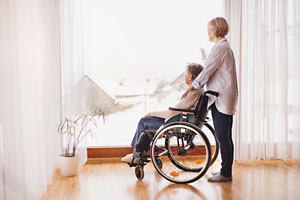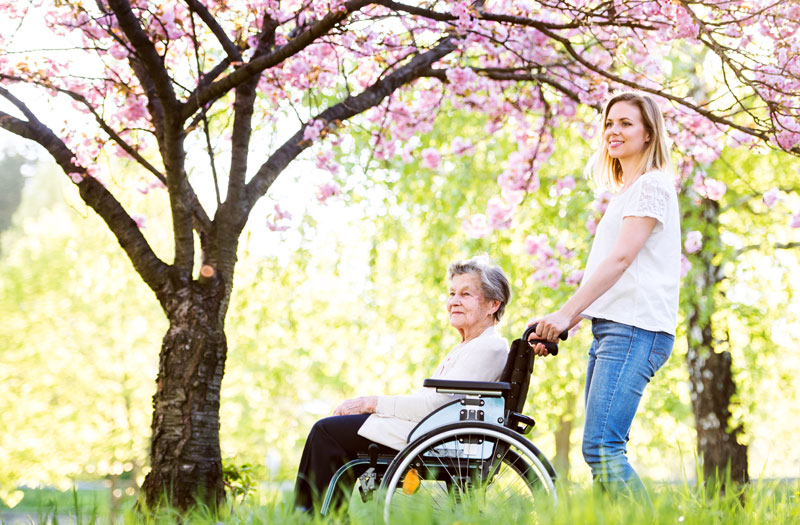Mindfulness, the act of focusing on being in the present, is sometimes thought of as a type of meditation. Recent studies show that practicing Mindfulness can be an effective strategy for home health care providers, including hospice patients, caregivers, and volunteers. By shifting the focus of hospice care away from states of emotional, mental, or physical distress – it can help reduce pain and anxiety. A growing number of hospice organizations are beginning to integrate these exercises into patient care and caregiver support.
What Is Mindfulness?
 Although the practices originate in meditation, no religious or spiritual beliefs are necessary to reap the benefits of pure attention. Being mindful is a state of simple awareness of the present moment, to observe without interfering, with an attitude of curiosity and acceptance. For example, focus completely on drinking a hot cup of herbal tea, taking in its taste, warmth, and scent – and when you drift off into other thoughts – gently return your focus to the taste and scent of your tea.
Although the practices originate in meditation, no religious or spiritual beliefs are necessary to reap the benefits of pure attention. Being mindful is a state of simple awareness of the present moment, to observe without interfering, with an attitude of curiosity and acceptance. For example, focus completely on drinking a hot cup of herbal tea, taking in its taste, warmth, and scent – and when you drift off into other thoughts – gently return your focus to the taste and scent of your tea.
The state of being mindful unites the body and mind in nonjudgmental and non-reactive awareness. This means that practitioners focus on experiencing bodily sensations, emotions, and thoughts independently of the reactions that form behavioral patterns over time. Even though mindfulness is a mental exercise and not a set of beliefs, the attention and awareness it can impart has been found to increase the ability of patients and caregivers to cope with anxiety, depression, and stress.
What Are Some Ways to Practice Being Mindful?
 One of the simplest ways to learn or teach mindfulness is to relax in a comfortable place and pay attention to the breath. The patient and caregiver may agree on a set amount of time during which they will focus only on inhalations and exhalations. The people performing this exercise should not make any attempt to control their breathing or any other mental activities or physical sensations. Instead, they should strive to become completely aware of the minute sensations of “embodied existence” (moment-to-moment awareness of what is) without any attempt to block out, categorize, or limit these experiences. Attentive to the felt sense of breathing, to the sounds of life around us, to the sensations in the body, and the flow of thoughts and feelings – sit quietly in the here and now.
One of the simplest ways to learn or teach mindfulness is to relax in a comfortable place and pay attention to the breath. The patient and caregiver may agree on a set amount of time during which they will focus only on inhalations and exhalations. The people performing this exercise should not make any attempt to control their breathing or any other mental activities or physical sensations. Instead, they should strive to become completely aware of the minute sensations of “embodied existence” (moment-to-moment awareness of what is) without any attempt to block out, categorize, or limit these experiences. Attentive to the felt sense of breathing, to the sounds of life around us, to the sensations in the body, and the flow of thoughts and feelings – sit quietly in the here and now.
If a patient is capable of breathing deeply, a caregiver instructing them in how to be mindful may show them how to focus on the belly, the nostrils, or the path that air takes down into the lungs. Feelings, thoughts, and physical sensations are likely to arise while the person practicing being mindful is being attentive to his or her breath. The practitioner should not attempt to control or suppress whatever arises, but accept and acknowledge these ideas and sensations both for what they are and what they are not.
Other methods involve counting the breath or repeating a sound, word, or phrase, such as “relax.” People training to become more mindful may also find it worthwhile to spend time paying attention to activities, surroundings, and even conversations. Any activity can be an opportunity to practice if an individual pursues it in a non-judgmental and non-reactive state of mind.
Try some “pet therapy.” Animals naturally live in the moment and tend to bring us comfort, so pets offer an excellent opportunity for mindfulness. They are sometimes referred to as “therapy animals” when specifically trained for the purpose. Spend some quiet moments mindfully observing an animal:
- See. Notice the patterns on their skin, coat, or feathers?
- Touch (if it’s safe and permitted). Is the animal smooth, soft, fluffy, silky, etc.?
- Listen. Notice the subtle sounds the animal makes as it moves, breathes or communicates?
- Savor the comfort that the animal provides.
 Savor mother nature. Luckily, here in the greater Tucson area of Arizona, the weather is often mild enough to spend a few minutes in a yard, garden or patio. Enjoy the warmth of the sun on your skin, mindfully watch the plants, birds, insects and sky. Watch the clouds as they slowly move across the sky. Notice the unique characteristics of a cactus in the desert landscape. Appreciate the sights and smells of mother nature, an item at a time, in detail. If circumstances don’t allow you to go outside, go to a window instead, or try to admire an item of beauty in your immediate surroundings.
Savor mother nature. Luckily, here in the greater Tucson area of Arizona, the weather is often mild enough to spend a few minutes in a yard, garden or patio. Enjoy the warmth of the sun on your skin, mindfully watch the plants, birds, insects and sky. Watch the clouds as they slowly move across the sky. Notice the unique characteristics of a cactus in the desert landscape. Appreciate the sights and smells of mother nature, an item at a time, in detail. If circumstances don’t allow you to go outside, go to a window instead, or try to admire an item of beauty in your immediate surroundings.
What Role Can Mindfulness Play in Hospice Care?
Studies suggest that being more mindful may significantly increase the quality of life for patients in hospice. Hospice caregivers can also benefit from working with patients to develop the mental skills necessary to become more mindful. By focusing on providing holistic care for patients’ bodies and minds, caregivers may find themselves coming to a clearer understanding of the end-of-life.
The benefits of this awareness can extend from patient to patient and empower hospice workers, including volunteers, in their own lives. Even if a hospice patient is not immediately open to learning how to be mindful, a caregiver can still provide some of the benefits by approaching care from this perspective. It is not unheard of for patients who are initially resistant to this concept to open their minds to mindful practice once they are exposed more to it.
How Can Mindfulness Influence Home Health Care?
 Learning how to become more mindful can help patients and private caregivers come to terms with terminal conditions and end-of-life care. Recent clinical trials and imaging studies have shown that this practice may reduce chronic pain by as much as 57 percent, even for patients who are not advanced meditators. Those who have been meditating for longer may reduce pain by up to 90 percent.
Learning how to become more mindful can help patients and private caregivers come to terms with terminal conditions and end-of-life care. Recent clinical trials and imaging studies have shown that this practice may reduce chronic pain by as much as 57 percent, even for patients who are not advanced meditators. Those who have been meditating for longer may reduce pain by up to 90 percent.
In addition to sitting and observing the breath or the cumulative aspects of existence, there are some collective practices that may prove beneficial for hospice care. When it comes to approaching the subject of death, some organizations focus on starting open conversations about death and dying. The goal of these conversations is to remain unattached from specific outcomes and allow for a non-directed conversation among patients and caregivers. It may be beneficial to host these open conversations in group sessions to increase the number of contributions and allow participants to learn from one another. Although these conversations are not directed, participants may benefit from addressing various dimensions of living, dying, and loss.
Other studies suggest that mindfulness can reduce or even prevent instances of burnout among hospice and palliative clinicians and caregivers. These practices can provide support for compassion and empathy and give both patients and caregivers an outlet that they can pursue anywhere at any time to support their own well-being and work.
How Can You Provide Mindful Hospice Care?
If you are interested in pursuing mindfulness with patients, there are many resources available. There is no distinction between mindful practices for hospice care and other types of mindfulness. The only limitations that emerge may involve physical motions or postures, all of which go beyond the basic practice. Encourage private caregivers and patients to take time to be aware of their embodied experience. Being mindful is a practice that is available to anyone, anywhere, in any phase of life.

